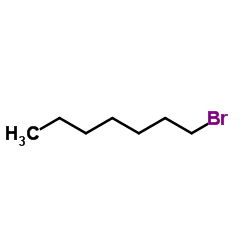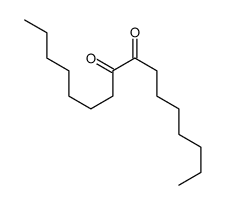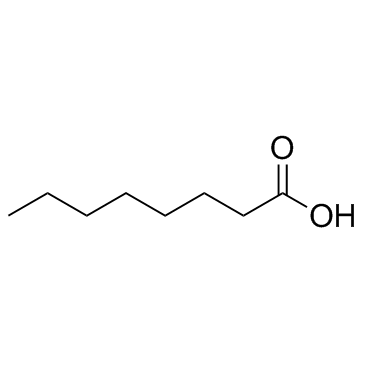8-Hexadecyne
Modify Date: 2024-01-10 16:05:20

8-Hexadecyne structure
|
Common Name | 8-Hexadecyne | ||
|---|---|---|---|---|
| CAS Number | 19781-86-3 | Molecular Weight | 222.409 | |
| Density | 0.8±0.1 g/cm3 | Boiling Point | 289.3±8.0 °C at 760 mmHg | |
| Molecular Formula | C16H30 | Melting Point | N/A | |
| MSDS | N/A | Flash Point | 124.5±12.6 °C | |
| Name | hexadec-8-yne |
|---|---|
| Synonym | More Synonyms |
| Density | 0.8±0.1 g/cm3 |
|---|---|
| Boiling Point | 289.3±8.0 °C at 760 mmHg |
| Molecular Formula | C16H30 |
| Molecular Weight | 222.409 |
| Flash Point | 124.5±12.6 °C |
| Exact Mass | 222.234756 |
| LogP | 7.84 |
| Vapour Pressure | 0.0±0.3 mmHg at 25°C |
| Index of Refraction | 1.450 |
|
8-Hexadecyne
Revision number: 5
SAFETY DATA SHEET Section1. IDENTIFICATION Product name:8-Hexadecyne Revision number:5 Section2. HAZARDS IDENTIFICATION GHS classification PHYSICAL HAZARDSNot classified HEALTH HAZARDS Aspiration hazardCategory 1 Not classified ENVIRONMENTAL HAZARDS GHS label elements, including precautionary statements Pictograms or hazard symbols Signal wordDanger Hazard statements May be fatal if swallowed and enters airways Precautionary statements: [Response]IF SWALLOWED: Immediately call a POISON CENTER or doctor/physician. Do NOT induce vomiting. [Storage]Store locked up. Dispose of contents/container through a waste management company authorized by [Disposal] the local government. Section3. COMPOSITION/INFORMATION ON INGREDIENTS Substance/mixture:Substance Components:8-Hexadecyne Percent:>99.0%(GC) CAS Number:19781-86-3 Chemical Formula:C16H30 Section4. FIRST AID MEASURES Inhalation:Remove victim to fresh air and keep at rest in a position comfortable for breathing. Get medical advice/attention if you feel unwell. Skin contact:Remove/Take off immediately all contaminated clothing. Rinse skin with water/shower. If skin irritation or rash occurs: Get medical advice/attention. Eye contact:Rinse cautiously with water for several minutes. Remove contact lenses, if present and easy to do. Continue rinsing. If eye irritation persists: Get medical advice/attention. 8-Hexadecyne Section4. FIRST AID MEASURES Ingestion:Immediately call a POISON CENTER or doctor/physician. Rinse mouth. Do NOT induce vomiting. Protection of first-aiders:A rescuer should wear personal protective equipment, such as rubber gloves and air- tight goggles. Section5. FIRE-FIGHTING MEASURES Dry chemical, foam, carbon dioxide. Suitable extinguishing media: Unsuitable extinguishing Water (It may scatter and spread fire.) media: Precautions for firefighters: Fire-extinguishing work is done from the windward and the suitable fire-extinguishing method according to the surrounding situation is used. Uninvolved persons should evacuate to a safe place. In case of fire in the surroundings: Remove movable containers if safe to do so. Special protectiveWhen extinguishing fire, be sure to wear personal protective equipment. equipment for firefighters: Section6. ACCIDENTAL RELEASE MEASURES Personal precautions,Use extra personal protective equipment (self-contained breathing apparatus). Keep protective equipment and people away from and upwind of spill/leak. Ensure adequate ventilation. Entry to non- emergency procedures: involved personnel should be controlled around the leakage area by roping off, etc. Environmental precautions: Prevent product from entering drains. Methods and materials for Absorb spilled material in a suitable absorbent (e.g. rag, dry sand, earth, saw-dust). containment and cleaning In case of large amount of spillage, contain a spill by bunding. Adhered or collected up: material should be promptly disposed of, in accordance with appropriate laws and regulations. Section7. HANDLING AND STORAGE Precautions for safe handling Handling is performed in a well ventilated place. Wear suitable protective equipment. Technical measures: Prevent generation of vapour or mist. Wash hands and face thoroughly after handling. Use a closed system if possible. Use a ventilation, local exhaust if vapour or aerosol will be generated. Advice on safe handling: Avoid contact with skin, eyes and clothing. Conditions for safe storage, including any incompatibilities Storage conditions:Keep container tightly closed. Store in a cool and dark place. Store locked up. Store away from incompatible materials such as oxidizing agents. Packaging material:Comply with laws. Section8. EXPOSURE CONTROLS / PERSONAL PROTECTION Engineering controls:Install a closed system or local exhaust. Also install safety shower and eye bath. Personal protective equipment Respiratory protection: Half or full facepiece respirator, self-contained breathing apparatus(SCBA), supplied air respirator, etc. Use respirators approved under appropriate government standards and follow local and national regulations. Impervious gloves. Hand protection: Eye protection:Safety goggles. A face-shield, if the situation requires. Skin and body protection: Impervious protective clothing. Protective boots, if the situation requires. Section9. PHYSICAL AND CHEMICAL PROPERTIES Physical state (20°C):Liquid Form:Clear Colorless - Very pale yellow Colour: 8-Hexadecyne Section9. PHYSICAL AND CHEMICAL PROPERTIES Odour:No data available pH: No data available Melting point/freezing point:No data available Boiling point/range:No data available Flash point:No data available Flammability or explosive limits: Lower:No data available Upper:No data available Relative density:0.80 Solubility(ies): [Water]No data available [Other solvents]No data available Section10. STABILITY AND REACTIVITY Chemical stability:Stable under proper conditions. Possibility of hazardous No special reactivity has been reported. reactions: Incompatible materials: Oxidizing agents Hazardous decomposition Carbon monoxide, Carbon dioxide products: Section11. TOXICOLOGICAL INFORMATION Acute Toxicity:No data available Skin corrosion/irritation: No data available Serious eyeNo data available damage/irritation: Germ cell mutagenicity: No data available Carcinogenicity: IARC =No data available NTP =No data available Reproductive toxicity:No data available Section12. ECOLOGICAL INFORMATION Ecotoxicity: Fish:No data available Crustacea:No data available No data available Algae: Persistence / degradability: No data available No data available Bioaccumulative potential(BCF): Mobility in soil Log Pow:No data available Soil adsorption (Koc):No data available Henry's LawNo data available constant(PaM3/mol): Section13. DISPOSAL CONSIDERATIONS Recycle to process, if possible. Consult your local regional authorities. You may be able to burn in a chemical incinerator equipped with an afterburner and scrubber system. Observe all federal, state and local regulations when disposing of the substance. Section14. TRANSPORT INFORMATION Hazards Class:Does not correspond to the classification standard of the United Nations UN-No:Not listed 8-Hexadecyne Section15. REGULATORY INFORMATION Safe management ordinance of dangerous chemical product (State Council announces on January 26, 2002 and revised on February 16,2011): Safe use and production, the storage of a dangerous chemical, transport, loading and unloading were prescribed. SECTION 16 - ADDITIONAL INFORMATION N/A |
| Hazard Codes | Xn |
|---|---|
| HS Code | 2901299090 |
|
~% 
8-Hexadecyne CAS#:19781-86-3 |
| Literature: Journal of Organic Chemistry, , vol. 37, p. 3245 - 3248 |
| HS Code | 2901299090 |
|---|---|
| Summary | 2901299090 unsaturated acyclic hydrocarbons。Supervision conditions:None。VAT:17.0%。Tax rebate rate:9.0%。MFN tariff:2.0%。General tariff:30.0% |
| Hexadec-8-in |
| diheptylacetylene |
| Hexadec-8-yne |
| 8-Hexadecyne |
| MFCD00046733 |


 CAS#:18229-29-3
CAS#:18229-29-3 CAS#:124-07-2
CAS#:124-07-2 CAS#:544-76-3
CAS#:544-76-3 CAS#:35365-53-8
CAS#:35365-53-8